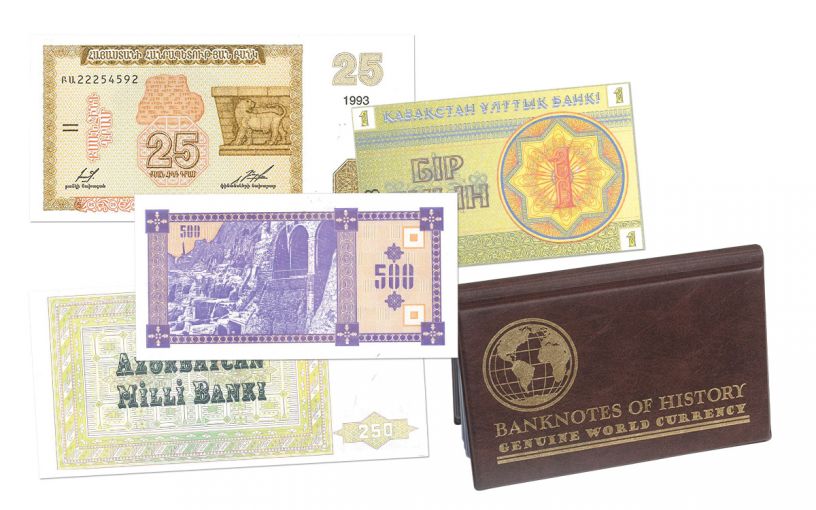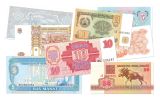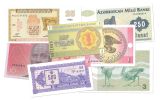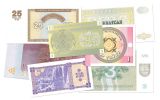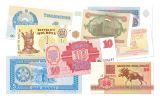Local Storage seems to be disabled in your browser.
For the best experience on our site, be sure to turn on Local Storage in your browser.
Rise and Fall of the USSR 15-Piece Banknote Set
An Instant Collection - Own a Unique Piece of Soviet Union History
How often do you have the opportunity to acquire 15 unique banknotes that directly tie to the history of the Soviet Union? The Declaration of the Creation of the USSR was approved on December 29, 1922 and on December 25, 1991, the USSR was self-dissolved by the Council of the Republics of the Supreme Soviet of the Soviet Union. The rise of the Soviet Union would see the death of Lenin and the rise of Stalin. In 1939, Stalin and Hitler signed a non-aggression pact including the partition of Poland and assigns the Baltic states to the Soviet Union. World War II begins when Germany invades Poland on September 1 and the Soviet Union invades Poland September 17.
Hitler and Stalin Join Forces, or Did They
Hitler had always regarded the German-Soviet nonaggression pact, as a temporary tactical maneuver. And on June 22, 1941, less than two years after signing the pact, Nazi Germany invaded the Soviet Union killing millions of people. Now the Soviets wanted revenge, Stalin wanted to take the capital of Berlin before the Western Allies as a symbol of the Soviet victory. In May of 1945 Berlin fell to Russia. Hitler poisoned his new wife and commited suicide. A few months later, in August 1945, the United States dropped atomic bombs on Hiroshima and Nagasaki essentially ending WW II.
The Fall of the USSR
When Stalin died, his successor, Khrushchev attempted to unwind what Stalin had done to Russia. This began a slow decline of the USSR as a world power. The period between 1947 and the eventual end of the USSR in 1991 was known as the cold war. The term "cold" is used because there was no large-scale fighting directly between the Western block (the United States and its allies) and the Eastern block (the Soviet Union and its allies), although there were regional wars such as Korea, Vietnam and Afghanistan. The Cold War split the wartime alliances leaving the Soviet Union and the United States as two superpowers with profound economic and political differences.
Eventually we come Gorbachev, who was elected general secretary march of 1985. He attempted to liberalise the USSR with glasnost and perestroika. However, the more restrictions he lifted, the greater the backlash from the Russian people until his government lost effective control of its people.
“Mr. Gorbachev, tear down this wall!"
With the help of Pope John Paul and Margaret Thatcher, Ronald Regan was able to stand at the Brandenburg Gate, June 1986, and say “Mr. Gorbachev, tear down this wall!" Which lead to signing of the nuclear-arms-reduction treaty
and eventually on 25th December 1991, Gorbachev officially announced the dissolution of the USSR, to be followed by a new, democratic Russian state.
After the collapse, one “Union” of Soviet Socialist Republics became 15 independent nations. Now you can own a complete set of the bank notes used by the citizens of the USSR.
- Armenia │25 Dram │ P34 | Obv: Frieze with lion from Erebuni castle │Rev: Arched ornament | Dimensions: 126 x 62 mm
- Azerbaijan │250 Manat │ P13 | Obv: Building and value │Rev: Alerbay Can Millibanki | Dimensions: 125 x 63 mm
- Belarus │ 25 Rublei │ P6 | Obv: Warrior wielding sword on horseback │Rev: Moose | Dimensions: 116 x 54 mm
- Estonia │ 10 Krooni P77 | Obv: J . Hurt at center, arms at upper right, ascending serial number at right│Rev: Tree | Dimensions: 140 x 69 mm
- Georgia │ 50 0 Laris │ P29 | Obv: View of Tbilisi with statue at center right │Rev: Cave dwellings | Dimensions: 105 x 54 mm
- Kazakhstan │ 1 Tyin │ P1 | Obv: Ornate denomination in circle │Rev: Circular arms | Dimensions: 102 x 66 mm
- Kyrgyzstan │ 1 Tyiyn │ P1 | Obv: Bald eagle │Rev: Ornate design | Dimensions: 90 x 71 mm
- Latvia │ 10 Rubli │ P38 | Obv: Value │Rev: Denomination within symmetrical design | Dimensions: 120 x 60 mm
- Lithuania │ 3 Talonu │ P33 | Obv: Numeral with juniper branch │Rev: Two grey herons | Dimensions: 121 x 77 mm
- Moldova │ 1 Leu │ P8a | Obv: King Stefan │Rev: Monastery at Capriana | Dimensions: 114 x 58.5 mm
- Russia │ 5 Rubles │ P239 | Obv: Kremlin Spasski Tower │Rev: Value | Dimensions: 114 x 58 mm
- Tadjikistan │ 1 Ruble │ P1 | Obv: Arms │Rev: Majlisi – Parliament | Dimensions: 102 x 55 mm
- Turkmenistan │5 Manat │P2 | Obv: Building, Value │Rev: Building | Dimensions: 126.5 x 63 mm
- Ukraine │ 1 Karbo vane t │ P81 | Viking sister, value │Rev: Cathedral of St. Sophia In Kiev | Dimensions: 105.5 x 54 mm
- Uzbekistan │ 1 Sum │ P61 | Obv: Arms │Rev: Mosque | Dimensions: 121 x 61.5 mm
All multiple historical banknotes are in a handsome leatherette folio with hot-stamped gold logo. The set includes stand-alone story card and certificate of authenticity all shipped in a beautiful black branded box. Image shows typical banknotes, not to scale and is for illustration purpose only. Banknotes in the albums will vary. Don’t miss your opportunity to own an instant complete collection of historic USSR bank notes.
| Availability | Out of Stock |
|---|---|
| Country | Various |
| Denomination | Varies |
| Coin Weight | 31.07 Grams - g |
|---|---|
| Dimensions | Various |

